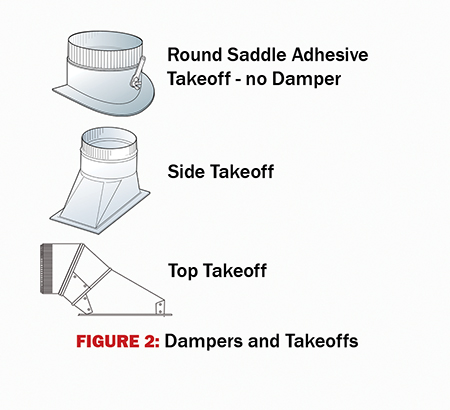- We have discussed flex duct on the return side, but I would like to point out the supply is a little different.
Flex Duct Considerations
The flex duct should be attached securely to the boot with the inner core pulled tight. The shorter the branch run, the better. Try to keep it to 15 ft. or less. There will be less chance for the compression to go over 4% (based on a 2004 Flex Duct Study published by Texas A&M).
The study found that if the compression increased to 15%, the friction rate doubled causing decreased airflow to the register.
NOTE: If the flex is over 15 ft., NCI suggests adding the appropriate amount of round pipe to complete the outlet run.

- Boot selection can be critical. Remember that the Equivalent Length (EL) of a 90° boot is 80 ft. According to ACCA Manual D – Group 4: ceiling/diffuser boxes could be EL = 35 – 60 ft. Choose carefully. Maybe look at straight boots (EL = 10 ft.) and an off-the-shelf (supply house) four-segment/gore adjustable elbow (EL = 20 ft.), if you can make it fit in the space. This probably won’t work in a finished basement because most joists are 7½-in. deep.
- Finally, don’t forget the Terminal Device, which is called the supply register. Check the throw, spread, face velocity, noise criteria, and CFM. Registers are not ornaments; they are a component of a sophisticated, well-designed HVAC system.
I have tried to give you enough information to improve static pressure and airflow, so go out and fix something!
Each one of these components will decrease the TESP a little but together can extend equipment life and improve how the whole system works.
One more word of caution, please do a Room-By-Room Load Calculation to verify equipment size and required airflow for each room.
Also, ask lots of questions and listen to the customer’s response. They don’t speak your language, but they live with the issues and called you because they want it fixed.
If you decide you would like a better understanding of what I covered, I suggest you schedule a date with NCI’s Duct System Optimization Class and get certified. I am always available to answer questions.
John Puryear has a background in duct renovating design, sheet metal fabrication, and installation in both commercial and residential HVAC. He currently serves the industry as an instructor for National Comfort Institute (NCI). If you’re a contractor or technician wanting to learn more about duct airflow, design, or renovation, contact John at ncilink.com/ContactMe.













Recent Comments